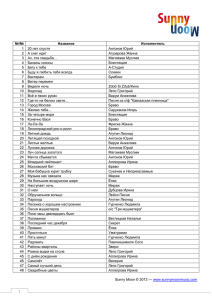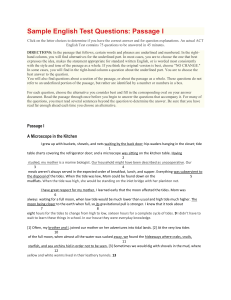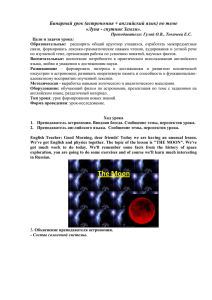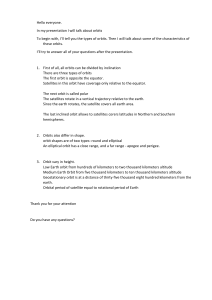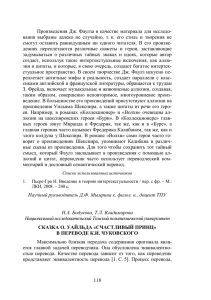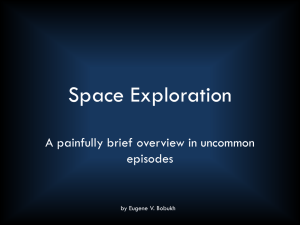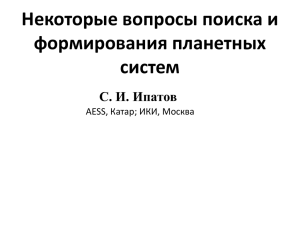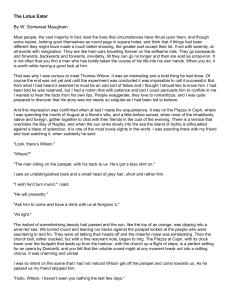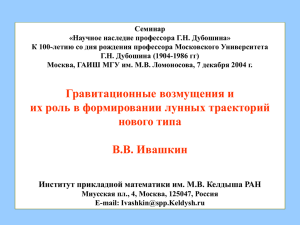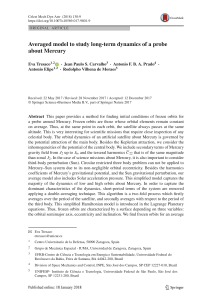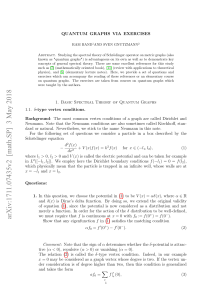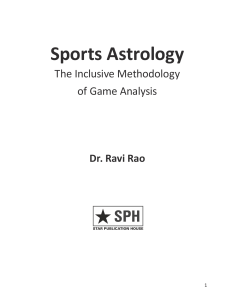Direct periodic orbits
advertisement
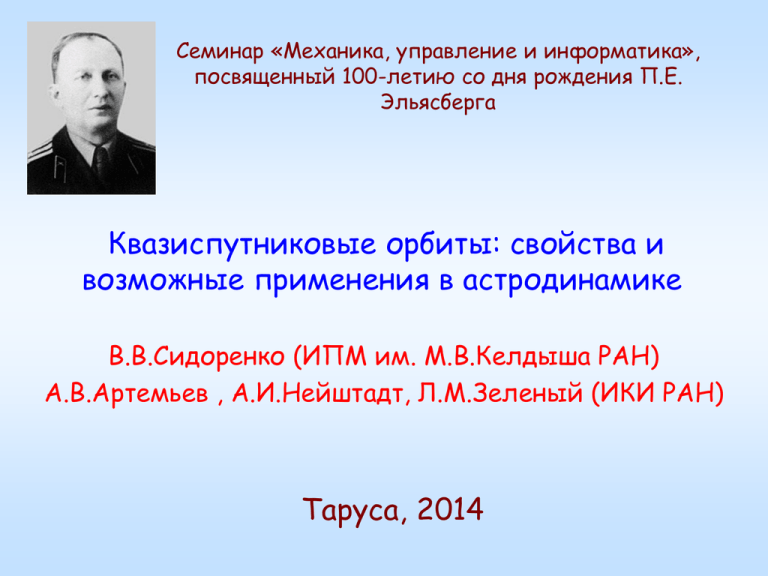
Семинар «Механика, управление и информатика», посвященный 100-летию со дня рождения П.Е. Эльясберга Квазиспутниковые орбиты: свойства и возможные применения в астродинамике В.В.Сидоренко (ИПМ им. М.В.Келдыша РАН) А.В.Артемьев , А.И.Нейштадт, Л.М.Зеленый (ИКИ РАН) Таруса, 2014 Квазиспутниковые орбиты 1:1 mean motion resonance! Resonance phase j=l-l’ librates around 0 (l and l’ are the mean longitudes of the asteroid and of the planet) J. Jackson (1913) – the first(?) discussion of QS-orbits Quasi-satellite orbits A.Yu.Kogan (1988), M.L.Lidov, M.A.Vashkovyak (1994) – the consideration of the QS-orbits in connection with the russian space project “Phobos” Phobos – one of the Mars natural satellites “Phobos-grunt” spacecraft Quasi-satellite orbits Namouni(1999) , Namouni et. al (1999), S.Mikkola, K.Innanen (2004),… - the investigations of the secular evolution in the case of the motion in QSorbit Real asteroids in QS-orbits: 2002VE68 – Venus QS; 2003YN107, 2004GU9, 2006FV35 – Earth QS; 2001QQ199, 2004AE9 – Jupiter’s QS …………………… Asteroid 164207 (2004GU9) No close encounters with Venus or Mars! Asteroid 164207 (2004GU9) Trajectory of the asteroid 2004GU9 Variation of the resonant phase Asteroid 164207 (2004GU9 ) The evolution of the orbital elements (CR3BP!) Model: nonplanar circular restricted three-body problem “Sun-Planet-Asteroid” = mPlanet 1 - small parameter of the problem mPlanet mSun Orbital elements l = l - mean longitude Nonplanar circular restricted three-body problem “Sun-Planet-Asteroid” Time scales at the resonance T1 - orbital motions periods T2 - timescale of rotations/oscillations of the resonant argument (some combination of asteroid and planet mean longitudes) T3 - secular evolution of asteroid’s eccentricity e, inclination i, argument of prihelion ω and ascending node longitude Ω . T1 << T2 << T3 Strategy: double averaging of the motion equations Nonplanar circular restricted three-body problem “Sun-Planet-Asteroid” Initial variables (Delaunay coordinates): L = (1 - )a , G = L 1 - e 2 , H = G cos i l, g = , h= First transformation: ( L, G, H , l , g, h) ( Pj , Pg , Ph ,j , g , h ) where Pj = L, Pg = G - L 1, Ph = H - L 1 j = l g (h - l ), g = g , h = h - l Nonplanar circular restricted three-body problem “Sun-Planet-Asteroid” Hamiltonian of the problem: (1 - ) 2 H =- Ph - Pj - R 2 2 Pj where the disturbing function is 1 R( Pj , Pg , Ph ,j , g , h ) = - (r, r) r - r Nonplanar circular restricted three-body problem “Sun-Planet-Asteroid” Partition of the variables at 1:1 MMR: dPj dPg dPh dg , , , ~ “slow” variables Pj , Pg , Ph , g dt dt dt dt dj “semi-fast” variable j ~ 1/2 dt dh ~ 1 “fast” variable h dt First averaging – averaging over the fast variable h : H avr 1 = 2 2 Hdh 0 Resonant approximation Scale transformation = ( L0 - L) / , = t = , Slow variables L0 = 1 Slow-fast system dx W dy W = , = - d y d x dj d W = 3, =d d j Fast variables 1 W (j , x, y , Ph ) = 2 2 3 2 H= W (j , x, y , Ph ) 2 = d dj -1dy dx SF-Hamiltonian and symplectic structure R(1, P ( x, y ), P , j , g ( x, y ), h )dh g 0 h - truncated averaged disturbing function Ph = 1 - e 2 cos i -approximate integral of the problem Averaging over the fast subsystem solutions on the level Н = ξ dx W = , d y V 1 = T ( x, y, , Ph ) T ( x , y , , Ph ) 0 dy W = - x W ( x, y, j ( , x, y, , Ph ), Ph ))d = x, y The accuracy of O( ) over time intervals ~ 1/ Problem: what solution of the fast subsystem should be used for averaging ? QS-orbit or HS-orbit? Nonplanar circular restricted three-body problem “Sun-Planet-Asteroid” Secular effects: examples Parameters: , Ph = 1 - e 2 cos i Scaling = 1 - Ph2 If <<1 then ~ i 2 e2 A – the motion in QS-orbit is perpetual B – the abundances of the perpetual and temporary QS-motions are more or less comparable C- the motion in QS-orbit is mainly temporary Asteroid 164207 (2004GU9) Current Variation of the resonant phase j and W Asteroid 164207 (2004GU9) Distant retrograde orbits in the Earth+Moon system • Preliminary investigation under the scope of CR3BP •Numerical investigation of SC dynamics in QSorbit, taking into account the perturbation due to the solar gravity field Main problem The Moon’s Hill sphere has a radius of 60,000 km (1/6th of the distance between the Earth and Moon). So the QS-orbits outside Hill sphere are large enough and experience substantial perturbations from the Sun. Preliminary investigation under the scope of planar CR3BP Motion equations: x - 2 y - x = -(1 - ) (x ) ( x - 1 ) r13 r23 1- y 2x - y = - 3 3 y r2 r1 Synodic (rotating) reference frame Jacobi integral 1- 2 CJ = x y 2 - x - y2 r2 r1 2 2 Distant retrograde periodic orbits (family f) Distant retrograde periodic orbits (family f) Stability indexes Sufficient stability condition (under the linear approximation): -1 a1 1, - 1 a2 1 Direct periodic orbits (family h1) Direct periodic orbits (family h2) Direct periodic orbits (families h1,h2) Stability indexes Sufficient stability condition (under the linear approximation): -1 a1 1, - 1 a2 1 Numerical integration, taking into account the gravity fields and actual motion of Moon, Earth and Sun (JPL DE405) 180 days in QS-orbit The initial distance to the moon - 40% of the distance Earth-Moon The initial epoch – 01/06/2012 Numerical integration, taking into account the gravity fields and actual motion of Moon, Earth and Sun (JPL DE405) 270 days in QS-orbit The initial distance to the moon - 30% of the distance Earth-Moon The initial epoch – 01/06/2012 Numerical integration, taking into account the gravity fields and actual motion of Moon, Earth and Sun (JPL DE405) 1.5 year in QS-orbit The initial distance to the moon - 25% of the distance Earth-Moon The initial epoch – 01/06/2012 Numerical integration, taking into account the gravity fields and actual motion of Moon, Earth and Sun (JPL DE405) First year in QS-orbit The initial distance to the moon - 25% of the distance Earth-Moon The initial epoch – 01/06/2012 Transfer trajectories to DRO Transfer trajectories to DRO Transfer trajectories to DRO Stable manifold of Lyapunov orbit as a transfer orbit? X.Ming, X.Shijie (2009) Применение квазиспутниковых орбит для «хранения» астероидов Циолковский: Исследование мировых пространств реактивными приборами (дополнение 1911-1912 гг) эксплуатация ресурсов астероидов Lewis, 1996 Перемещение астероидов в окрестность Земли www.planeatryresources.com Спасибо за внимание!
